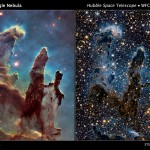My minister at the Unitarian congregation I attend recently started a sermon series on “Dangerous Words”, which include words like “prayer” and “sin”. That there are considered “dangerous words” says a lot about Unitarianism. Anyway, it got me thinking about what would be considered a “dangerous word” to Pagans. The first one that popped into my mind was “transcendence.”
Recently, B.T. Newberg posted a 4-part series of essays about transcendence at the Humanistic Paganism blog, starting with this one: “Three Transcendents: Naturalistic Transcendence“. B.T. then devoted a separate post to each one of the three transcendents: Nature, Community, and Mind. B.T. defines transcendence as an experience of something greater than ourselves. It is an experience which challenges and transforms us. In elaborating on each one the three transcendents, B.T. draws on Loyal Rue’s distinction, in Religion is Not About God, between “numinous experience” and “mystical experiences”. Numinous experiences are experiences of otherness, of transcendence, where we do not expect to encounter it. Mystical experiences, on the other hand, are experiences of union or identification with the other, with the object of the numinous experience. Both experiences have the tendency to attract and “fascinate” and the tendency to invoke “trembling”, or rather to shake us to our core.
Nature
I think both numinous and mystical experiences can be found in the context of each of B.T. three “transcendents”. In the context of nature, especially wild nature, the experience of otherness is common. We also experience this otherness when contemplating the vastness of the cosmos. When this experience reaches a certain intensity, it is called “numinous”. While we tend to find this experience in unfamiliar natural settings, like wild nature or unreachable places in the cosmos, we can find it in familiar settings, like the backyard, although it is harder. As George Orwell wrote, “To see what is in front of one’s nose needs a constant struggle.” We don’t really see the familiar. Instead we see our projections. So we often need to escape the familiar and go into the wild to experience nature as “other”.
We can also have the mystical experience of connectedness with nature. As Neil DeGrasse Tyson explains:
“So that when I look up at the night sky and I know that yes, we are part of this universe, we are in this universe, but perhaps more important than both of those facts is that the Universe is in us. When I reflect on that fact, I look up – many people feel small because they’re small and the Universe is big – but I feel big, because my atoms came from those stars. There’s a level of connectivity. That’s really what you want in life, you want to feel connected, you want to feel relevant you want to feel like a participant in the goings on of activities and events around you. That’s precisely what we are, just by being alive.”
Jung described his experience of connectedness in Memories, Dreams, Reflections. Writing about the time he spent at the “Tower” at Bolingen, he said:
“At times I feel as if I am spread out over the landscape and inside things, and am myself living in every tree, in the plashing of the waves, in the clouds and the animals that come and go, in the procession of the seasons.”
Other People
This dual experience of otherness and oneness can also be found the context of community. We might think that the experience of the “otherness” of other people is a given, but after giving it some thought, I don’t think so. I think our primary experience of other people, like our experience of nature, is of our own projections. I think most everyone has had the experience of talking to someone and, suddenly, for the first time you really see them, see them as a unique individual, remarkably different from yourself and your projections. That experience can both fascinate and shake us.
James Faulkner draws on Emmanuel Levinas to explain how we can experience transcendence in the encounter with other people:
“Levinas argues that when I experience the other person as a person, she breaks through the sphere of my otherwise solitary, ego-centered, conceptual world. Most of the time I live in a world of my conceptualizations and representations. There everything is encountered as if my will and I were the center of the world: the merely ordinary world. Exposure to another person in herself disengages me from that world. As a person, the other person overflows my understanding of her as an object, as something I conceive of—and by overflowing my understanding she interrupts my consciousness. She reveals its limits. My encounter of her is […] overpowering, amazing, and bedazzling […]
“[…] my encounter with another person who overflows my idea of her reveals that I am finite. I have limits; there are others outside beyond me, my will, and my understanding. My encounter with the other person as person is an encounter with infinity—with what is beyond my limits.”
In this way, you have to get to know someone in order to experience their difference, otherwise they remain an object for you, a mere projection. And then, as we get to know them even better, we can begin to experience their sameness; we can experience true connection. And that connection can be mystical. In can occur during sexual intercourse, but it can also occur during simple conversation. But in order to reach that experience of connection, I think we first have to get over the false sense of familiarity and really learn to see the person; a person must first be “other” before we can truly connect with them.
Self
Finally, we can experience both the transcendent otherness and the mystical oneness within our own psyches. I’ve written a lot about the “otherness” of the experience of the archetypes. See my posts on this blog, “Are the Gods Real?” and “What is it that rules outside man’s self?: The gods as ‘other'”. This is how Jung describes the experience of the archetypes:
“[Humankind] cannot grasp, comprehend, dominate them [numinous experiences]; nor can he free himself or escape from them, and therefore feels them as overpowering. Recognizing that they do not spring from his conscious personality, he calls them mana, daimon, or God. […] Therefore the validity of such terms as mana, daimon, or God can be neither disproved nor affirmed. We can, however, establish that the sense of strangeness connected with the experience of something objective, apparently outside the psyche, is indeed authentic.
“We know that something unknown, alien, does come our way, just as we know that we do not ourselves make a dream or an inspiration, but that it somehow arises of its own accord.”
(emphasis added).
These archetypal experiences originate in the unconscious which is also, in a sense, transcendent. As John Dourley explains, Jung displaces the “the three transcendental gentlemen populating the monotheistic heavens”.
“In their stead he understands transcendence as the intra-psychic transcendence of the archetypal unconscious to its various incarnations in human consciousness. In thus revisioning the process of incarnation as wholly within the psyche, it is important to note that the fecundity of the archetypal will always outstrip its incarnations in consciousness. There will always be more to become incarnate. This understanding of incarnation denies to any religion or archetypal equivalent the status of unqualified ultimacy or finality.”
Again, as with nature and other people, I think this transcendent or numinous experience of otherness within our selves is a precondition of the mystical experience of unity. We have to discover the archetypes as agencies acting independent of our conscious will before we can integrate them into our conscious lives. As Jung wrote, “If we step through the door of the shadow we discover with terror that we are the objects of unseen factors. […] Only an unparalleled impoverishment of symbolism could enable us to rediscover the gods as psychic factors, that is, as archetypes of the unconscious.”
Lateral Transcendence
“Transcendence” is a word that takes a lot of heat from Pagans. Usually, “transcendence” is juxtaposed with “immanence”, and the former is understood as the belief in a God that is outside the world, and outside nature. The implication of this belief is that absolute truth is to be found (revealed from) outside of the human condition, outside of our embodiment, outside of our connections to the world around us, and outside of our relationships with one another. It splits the cosmos into two parts: one part associated with God-heaven-spirit-mind-culture-light-male-sacred and another part associated with human-earth-matter-body-nature-dark-female-profane.
But the kind of transcendence under discussion here is different than what Pagans ordinarily associate with that term. It is, in the words of Christian theologian R. H. J. Steuart, it is
“an otherness which not only does not exclude but positively (just because it is what it is) includes and demands oneness — a oneness, indeed, which is actually more real and intimate than what we would normally describe as identification.”
Drawing on the world of Ursula Goodenough, Michael Kalton, and Vaclav Havel, and Merleau-Ponty, Phil Hine describes a “lateral (or horizontal) transcendence” and speaks of “transcendence-toward-immanence”. (Hine’s entire posts — here and here — are great and well worth reading.) Lateral transcendence is first and foremost relational. Hine describes it as “a ‘reaching out’ towards the world and a commitment to widening one’s perspective.”
“Transcendence, in these terms, is not some unknowable absence, but a feature of phenomena as they announce themselves within a horizon. Transcendence means that what is perceived ‘always contains more than what is actually given’ – that any phenomenon has the capacity to surprise us, to broaden or even explode our horizons. Lateral transcendence can be thought of as a reaching-beyond the boundaries of isolated selfhood towards the web of relationships, and perhaps, an openness to novelty, surprise, the unexpected.”
I also like Hine’s term, “transcendence-toward-immanence”, because is suggests that the one (lateral transcendence) leads to the other (immanence), just as I have described above how the numinous experience of otherness can lead to the mystical experience of connection.
Rather than leaving behind the world, and nature, and other people, lateral transcendence or “transcendence-toward-immanence” encompasses these all things. As we move through the numinous experience of otherness, with nature, with other people, and with our own selves, we move into the mystical experience of connection, then the scope of our compassion increases. This process moves us toward a kind of wholeness which is, as Jungian John Dourley explains, a “paradoxical combination of greater personal integration and extended universal empathy.” Dourley suggests that the depth of one’s penetration into the Source determines the breadth of one’s compassion. And this, I think, is the point. Intense experiences transcendence or mystical union can help us live life more fully. But if we stop there, then we risk these experiences becoming just another stimulant in a world of empty stimulation. These experiences need not be an end in themselves: they can broaden and deepen our compassion for the non-human world around us, for the human community, and even for our selves.















